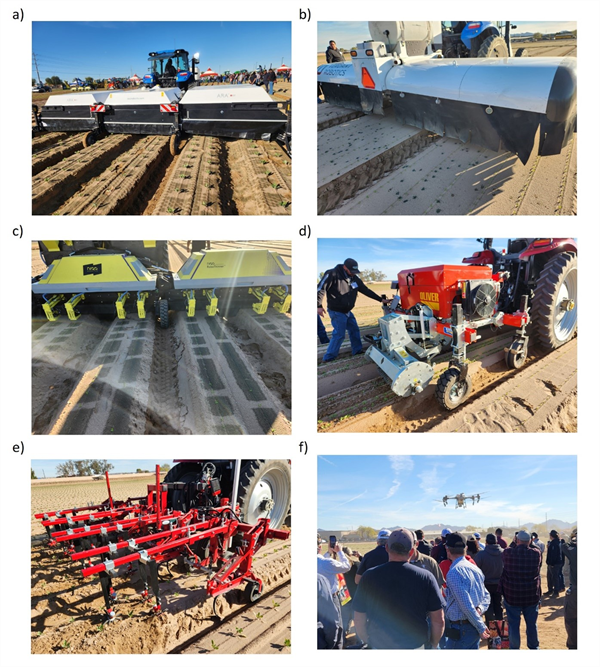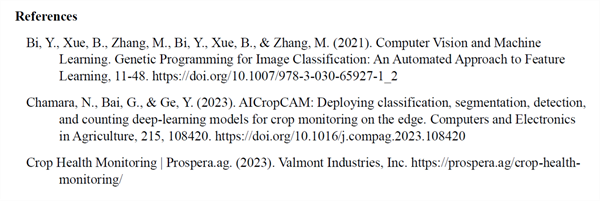
In the last two issues of this UA Vegetable IPM Newsletter, I have presented a melon (Cucumis melo ‘reticulatus’ L.) crop phenology model (Figure 1; Silvertooth, 2025a) based on actual heat unit accumulations (86/55 ºF thresholds). This model can be useful in predicting and tracking crop development and identifying important stages of crop growth and development (crop phenology).
Referring to the data from AZMET for several locations in the Yuma area, the HU accumulations from 1 January 2025 for a set of four possible 2025 planting dates are listed in Table 1. The HU accumulations from 1 January 2025 to 28 April 2025 for these sites are listed in Table 2.
The HU accumulations after planting (HUAP) for these four possible planting dates for three Yuma area locations to 28 April 2025 are shown in Table 3. The HUAP values in Table 3 are simply the difference between the values in Tables 1 and 2.
An example for the Yuma Valley, 15 January 2025 planting date is: HU from 1 January to 28 April 1096 - 73 HU accumulated at planting on 15 January = 1023 HUAP for this case.
The information in Table 3 can help serve as a reference to check for melon crop
development in the field against this phenological model in Figure 1. In the most edition of this newsletter (Silvertooth, 2025b) the projected stages of growth were presented based on this phenological model and current HU accumulations.
Based on this phenology model and current HU accumulations for this season we should be able to make some projections on the current stage of growth, which we can go to the field and check. For example, for melon fields in the lower Colorado River Valley at this time, we can expect to find fields planted and watered up in mid-January to have crown set melons maturing and approaching harvest conditions. These fields could have crown fruit ready for harvesting in about three weeks, based on these projections and normal HU accumulation patterns for this time of year. For fields planted and wet dates near the first of March, these fields should have small crown set melons approaching golf ball size.


Table 1. Heat unit accumulations (86/55 ºF thresholds) after 1 January 2025 on four
possible 2025 planting dates utilizing Arizona Meteorological Network (AZMET) data for
each representative site.
Yuma Valley: https://azmet.arizona.edu/application-areas/heat-units/station-level-summaries/az02
Yuma North Gila: https://azmet.arizona.edu/application-areas/heat-units/station-level-summaries/az14
Roll: https://azmet.arizona.edu/application-areas/heat-units/station-level-summaries/az24

Table 2. Heat unit accumulations (86/55 ºF thresholds) after 1 January 2025 to 14
April 2025 utilizing Arizona Meteorological Network (AZMET) data for each
representative site.

Table 3. Heat unit accumulations (86/55 ºF thresholds) after planting (HUAP) from four
possible 2025 planting dates and three sites in the Yuma area on 30 April 2025 utilizing
Arizona Meteorological Network (AZMET) data for each representative site. Each value
is rounded to the next whole number. Note: the values in Table 3 are determined by
taking the difference between the HUs for each representative site and four planting
dates in Tables 1 and 2.

Figure 1. Melon (cantaloupe) phenological development model expressed in Heat Units
Accumulated After Planting (HUAP, 86/55 oF).
Frost and freeze damage affect countless fruit and vegetable growers leading to yield losses and occasionally the loss of the entire crop. Frost damage occurs when the temperature briefly dips below freezing (32°F).With a frost, the water within plant tissue may or may not actually freeze, depending on other conditions. A frost becomes a freeze event when ice forms within and between the cell walls of plant tissue. When this occurs, water expands and can burst cell walls. Symptoms of frost damage on vegetables include brown or blackening of plant tissues, dropping of leaves and flowers, translucent limp leaves, and cracking of the fruit. Symptoms are usually vegetable specific and vary depending on the hardiness of the crop and lowest temperature reached. A lot of times frost injury is followed by secondary infection by bacteria or opportunist fungi confusing with plant disease.
Most susceptible to frost and freezing injury: Asparagus, snap beans, Cucumbers, eggplant, lemons, lettuce, limes, okra, peppers, sweet potato
Moderately susceptible to frost and freezing injury: Broccoli, Carrots, Cauliflower, Celery, Grapefruit, Grapes, Oranges, Parsley, Radish, Spinach, Squash
Least susceptible to frost and freezing injury: Brussels sprouts, Cabbage, Dates, Kale, Kohlrabi, Parsnips, Turnips, Beets
More information:
At the 2025 Southwest Ag Summit Field Demo a couple of weeks ago, many of the latest technologies were demonstrated in the field. Most were related to pest control. Several of the technologies demonstrated are new to the Yuma, AZ area. The recent technologies presented included two types of high precision spot sprayers for weeding and applying beneficial pesticides (Fig. 1a, Fig. 1b) and an AI based lettuce thinner. Manufacturers stated the technologies will be getting even better/more versatile soon. Both precision spot sprayer companies are developing models for small lettuce so that the machines can also be used for lettuce thinning. Also new was that the AI lettuce thinner technology is being further developed so that the device can be used also be used as a weeder. Several “older” pest control technologies also seemed to garner a lot of interest. These included an implement designed for cultivating high density crops (Fig. 1d), a camera guided cultivator equipped with in-row weeding tools (Fig. 1e) and a field scale drone sprayer (Fig. 1f).

Fig. 1. Newer pest control technologies demonstrated at the 2025 Southwest Ag Summit
Field Demo included a) Ecorobotix1 Ara high precision spot sprayer, b) Verdant Robotics
Sharp Shooter, c) Niqo Robotics AI based lettuce thinner, d) Oliver high density
cultivator, e) Steketee IC Light camera guided cultivator and f) DJI Agras T50 drone
sprayer.

In the August 21, 2024 update we mentioned our plans to do a demonstrative trial at the Yuma agricultural center. This experiment was established on 10/2 and planted on 10/14. Sprinklers started on10/15. A stand evaluation was done on 10/28 and Phytotoxicity and Goosefoot and Lambs quarter weed control evaluated yesterday. The treatments suggested by some of the people in the industry, where:
Treflan (trifluralin) Applied at 1.5pt/A pre-emergent on the flat ground incorporated mechanically by disking approximately at 4” depth, then make the beds and plant the crop to germinate with sprinkler irrigation. The same method was utilized for Prowl herbicide at the rate of 1 pint product per acre. Also Prowl non-incorporated was included, Devrinol2XL at 1 pt/A, Prefar at 6qt/A as well as a high rate of Goal (oxifuorfen)preemergence to evaluate and document phytotoxicity levels.
As mentioned, we have collected weed control data, which we plan to include in future updates.
Would you like to see how this treatments look? Some of the observations, even though expected are very interesting, such as the fact that 16 floz of Goal Tender preemergence didn’t allow goosefoot germination but similarly broccoli didn’t emerge.
Come to the NW corner of the Ag Center (you can’t miss it) and look at the plots and see the difference between Prowl mechanically incorporated and non-incorporated, compare it with Prefar and Devrinol. We put some very clear signs as you can see in the picture above. The experimental plots are 14x60ft so they are large enough to illustrate what would happen in a farm.
We thank you for your suggestions ...please come and let us know what you think!

Western Flower thrips is among the most economically important insect pests that infests desert lettuce. Bean thrips started to become a major pest of fall lettuce in the desert over the last decade. Our objective is to determine alternative organic insecticides that can be used as part of an IPM program targeting these pests in leafy vegetable crops.
This fall, at the YAC experimental farm, we evaluated 10 organic insecticides frothier efficacy in suppressing western flower thrips and bean thrips in organic head lettuce. M-Pede, Pyganic, and Aza-Direct were evaluated with Oroboost included in one treatment and Orbit DL included in the other treatment. Thus, we evaluated these aforementioned insecticides in two different treatment entries. The purpose was to understand the performance of these insecticides with Orbit DL or Oroboost as adjuvant. The remaining insecticide treatments had only Oroboost as adjuvant. Both Oroboost and Orbit DL are OMRI approved organic adjuvants.
We expected that several of these bioinsecticides would exhibit some measurable level of thrips suppression. However, our data showed that only Entrust exhibited measurable reduction in immature thrips, western flower thrips, and bean thrips numbers (Fig. 1-3). Gargoil and Pyganic with the Orbit as adjuvant exhibited a slight reduction in western flower thrips adults (Fig. 2). We will continue to evaluate these organic insecticides against the thrips to gather more research-based evidence which will allow us to draw more accurate conclusions and make relevant recommendations.

Figure 1. Mean thrips nymph/plant as affected by organic insecticide application.
DAT=Day After Treatment.

Figure 2. Mean western flower thrips adult/plant as affected by organic insecticide
application. DAT=Day After Treatment.

Figure 3. Mean bean thrips adult/plant as affected by organic insecticide application.
DAT=Day After Treatment.
Organic farming faces two major challenges: weeds, which remain the number one concern, and insect pressures that can severely affect crop quality and yields. Effective strategies for managing weeds and insects are critical, especially as organic production expands. Traditionally, these tasks have been labor-intensive and time-consuming, creating a strong need for innovative solutions that can improve efficiency while maintaining crop standards. With the current momentum for increased AI integration into agriculture supported by both industry and Washington D.C., novel technologies AICropCAM present exciting opportunities for leafy green growers. These high-tech platforms could offer early-stage detection of weeds and insects, helping growers respond more quickly and precisely. Such innovations have the potential to save significant time and labor, particularly across large acreages, while improving overall crop management decisions.
What is AICropCAM, and How Does it Work?
AICropCAM (Figs. 1, 2, & 3) is an advanced edge image processing platform designed to extract plant and canopy features directly from field crops. Its structure includes three key layers:
One of AICropCAM’s biggest advantages is its ability to perform deep learning-based image processing directly in the field. This means it can detect subtle signs of weed emergence or insect damage in real-time, capturing critical information that traditional imaging or simple sensors often miss. Edge computing also significantly reduces the need for high-bandwidth data transmission, a major limitation in rural agricultural areas.
Looking Ahead
Incorporating AICropCAM into leafy green production systems could help growers proactively manage weeds and insect pressures, optimize resource use, reduce chemical interventions (especially important in organic systems), and save time and labor. These technologies offer a glimpse into the future of precision agriculture, where early detection and informed decision-making can significantly boost sustainability and profitability.

Figure 1 (left): AICropCAM-insect detection, Figure 2 (middle): AICropCAM-weed
detection, Figure 3 (right): AICropCAM-installed in the field.

Results of pheromone and sticky trap catches can be viewed here.
Corn earworm: CEW moth counts remain at low levels in all areas, well below average for this time of year.
Beet armyworm: Trap increased areawide; above average compared to previous years.
Cabbage looper: Cabbage looper counts decreased in all areas; below average for this time of season.
Diamondback moth: DBM moth counts decreased in most areas. About average for this time of the year.
Whitefly: Adult movement beginning at low levels, average for early spring.
Thrips: Thrips adult counts reached their peak for the season. Above average compared with previous years.
Aphids: Aphid movement decreased in all areas; below average for late-March.
Leafminers: Adults remain low in most locations, below average for March.